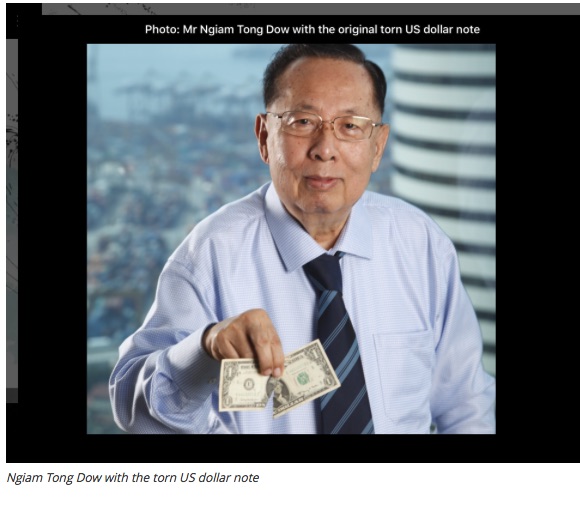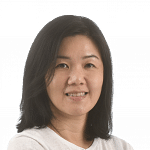.
============
.
Not everyone can be the prime minister…Dr Goh knew that he could not be.
.
All the men around the late Lee Kuan Yew [LKY] were not men who were made up to be ready to take over the post of prime minister from LKY in the 1960s.
The key inner-circle men were Dr Goh Keng Swee, Dr Toh Chin Chye, Lim Kim San, S. Rajaratnam, EW Barker, and Ong Pang Boon.
There was no threat to LKY. All these men knew it was a tough battle ahead taking on and going against the British colonial masters, the racial communalists and the communists plus facing the challenges in building an independent state after being kicked out by Malaysia when merger failed.
It was no easy task. Lesser men would have cracked under that kind of pressure.
It was too big a task for these men even if they were to hold the pm post not as an individual but to govern collectively as a team.
They did not have it in them to replace LKY and to take on the struggles, to shoulder and to build up an independent nation when there were no hopes in sight.
Some of them did not have the gift of the gap, the oratory skills like LKY, to influence the population, the unions and the workers.
Some were not ready due to the period and time where the Chinese language and culture had a great influence on the ground. Not all of them including LKY were educated in Chinese. Anyone from the minority race would not do to be the prime minister even if thrust upon him to take on the role of pm replacing LKY.
Dr Goh and Dr Toh did not have the oratory skills like LKY, and the charisma to influence the people to accept, and to go along with them.
Dr Goh knew he was not cut for the pm post but that he had the skills and intellect suited for economics and finance, with focus on development economics. Dr Toh knew he was better to be left behind the scene, not in the limelight, but to be a political thinker and strategist.
It was providence of the time in the 60s and merging of circumstances for Singapore to be fortuitously endowed with a team of giants making up of a few men able to work together, to stay focused on their respective roles, and contributing in their own way, thus bringing about political stability, harmony and strength, and economic progress in leaps and bounds year after year.
Many countries went independent from the British colonial masters with great hopes and promises of nationalism, and many leaned harder on the left. Some played with the racial card championing the indigenous majority race to rule.
Singapore did the opposite opening its doors to foreign investments from the West. The investors brought their outdated machines to industrialise and use cheap labour relying on the use of the English language as the medium of communication. The CPF system was systematically enhanced by the government not to allow the MNCs to cream off everything while enjoying cheap industrial factory labour.
Those were the times where these few men at the top of government served unselfishly for the sake and love of the nation expecting no rewards and personal gain in return. It was like doing their ‘national service’ for country but not in military uniform, and not housed in camps and barracks.
.
===================
.
My above comments in themiddleground.sg [please see article below by Ms Bertha Henson]:
E-book on GIC, the link: http://gichistory.gic.com.sg/files/ebooks/GIC_History.pdf
.
==========
==========
.
Conviction, openness key to S’pore’s success, says DPM Heng at Albert Winsemius book launch

SINGAPORE – It was a conviction to do what was right for the people and an openness to take on new ideas and try different approaches that led Singapore’s founding fathers to work closely with Dutch economist Albert Winsemius on economic transformation, said Deputy Prime Minister Heng Swee Keat on Monday (May 23).
And these two key values of conviction and openness are all the more salient today as the country navigates a world that has become more divided and insular, he added.
DPM Heng was speaking at the launch of the book Albert Winsemius And Singapore: Here It Is Going To Happen, which is about the life of the Republic’s chief economic adviser for close to a quarter-century.
The Dutchman, who came to Singapore as a leader of a United Nations Development Programme mission in 1960, was instrumental in promoting a pro-business environment, advocating training for workers and establishing the National Wages Council, helping to move the island up the value chain.
At a time when newly independent states were mostly industrialising through replacing foreign imports with domestic production, he advised Singapore to challenge the orthodoxy and connect with other advanced economies and pursue foreign investment to create jobs.
DPM Heng said: “Key to our economic story was that our founding fathers were prepared to get down to the basics, to innovate and go against the grain of conventional wisdom… Dr Winsemius was a most valuable guide in this effort. ”
He noted that this underlies many other aspects of Singapore’s economic and social policies, such as building up retirement savings through the Central Provident Fund, promoting affordable home ownership through Housing Board flats and encouraging lifelong learning through SkillsFuture.
“We must continue to have the conviction to do what is good and right for Singapore and Singaporeans, even if it means going against conventional norms,” he added.
Although Dr Winsemius was not a Singaporean, “was not born here, and did not grow up here”, said DPM Heng, that was no impediment for founding prime minister Lee Kuan Yew and then Finance Minister Goh Keng Swee who worked closely with him.
“Given that he had no prior nexus with Singapore, it is remarkable that he developed such a strong affinity for Singapore. His heart was with Singapore, and he was committed to do good by Singapore and help our people succeed,” he added.
“The Singapore Story would have been a very different one, if we had decided not to pursue his recommendations simply because it did not originate here. In fact, our openness – to ideas, investments and people from all over the world – has been a critical factor in our success.”
At a time when many societies are turning inwards, it has become even more important for Singapore to remain open “to the best people, ideas and support from around the world” and to focus on what is best for the country, said DPM Heng.
“We must continue to develop deep capabilities, to equip ourselves to work together with the best around the world, to take on new opportunities and make a difference. As an island state, our success rests on our openness and connection to the world.”
Dr Winsemius’ contributions to Singapore’s economic growth and development are covered in detail in the 1,000-page book by Nanyang Technological University Albert Winsemius chair professor of economics Euston Quah and his co-authors, NTU research associates Luke Nursultan Iuldashov and Zach Lee.
It also gives a glimpse into his life as a cheesemaker in the province of Friesland in the Netherlands and contains reminiscences of those who crossed paths with him, such as Emeritus Senior Minister Goh Chok Tong and National Wages Council founding chairman Lim Chong Yah, who were among the 220 guests at the book launch.

Attending the event at the National Museum, Dr Pieter Winsemius, son of Dr Winsemius who died in 1996, said the book is the final chapter of his father’s adventure and a “closure on a mighty adventure for us”.
“My father came here three weeks, twice… a year, which I still can’t believe. I was a consultant my whole life that you can… get a relationship like this, in three weeks, and another three weeks, and it’s a lasting relationship, the key word is trust… absolute trust,” said the retired politician who was Minister of Housing, Spatial Planning and the Environment in his country in the 1980s.
“My father was extremely fond of Singapore, and we grew up with Singapore. It’s my father’s home away from home, and it became our second home as well, without ever being here,” he added to laughter.
The younger Dr Winsemius, who had specially come to Singapore for the book launch with his children and the children and grandchildren of his two sisters, had brought a block of cheese as a gift for the authors, quipping that his father had always said “selling cheese is much more difficult to do than anything else, making policy and things like that”.
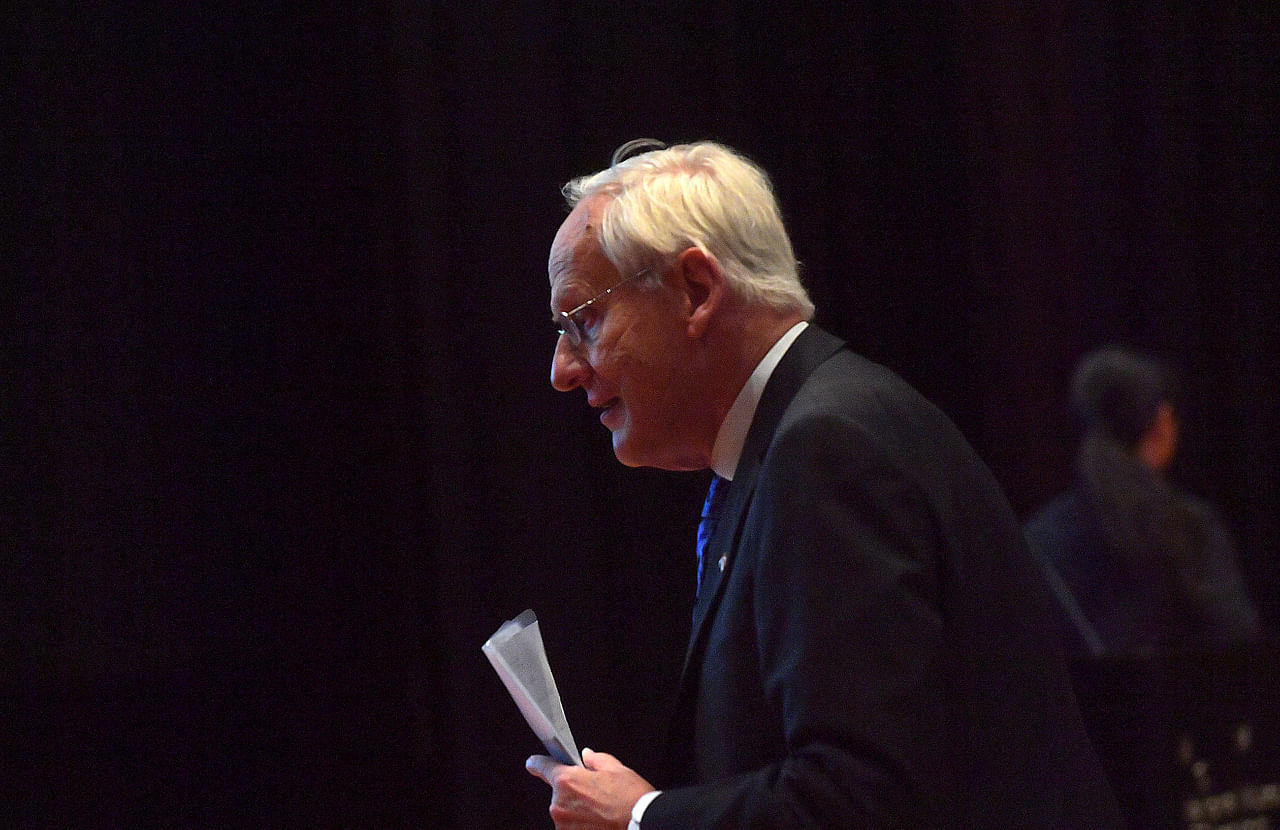
Singapore was still a British colony when Dr Winsemius first arrived in 1960 and had just achieved self-government. The economy was undeveloped, educational attainment was low and unemployment was over 12 per cent.
DPM Heng said: “The prospects were bleak. But fortunately, from the very beginning, Dr Winsemius saw the potential of our country.”
The economist and his team, who had been tasked by the UN to help Singapore industrialise, presented the Government with what is better known as the Winsemius Report, which guided the country’s economic development.

Foreign Minister Vivian Balakrishnan, who also spoke at the event, told an anecdote about how Dr Winsemius had advised the Government to keep the statue of Sir Stamford Raffles along the Singapore River, even though the country was shedding its British colonial past.
“That’s because he and our founding fathers… envision a globalised, connected Singapore, one that was open for business,” he said.
Leaving the statue would send a signal to investors that Singapore was at peace with its history and comfortable in its own skin, and that the country would remain open to talent, ideas and technology from everywhere, added Dr Balakrishnan, noting that this continues to be a lifelong habit of Singapore.

The younger Dr Winsemius said his father derived great pride from working with Singapore’s early leaders such as Mr Lee, Dr Goh and former minister and Economic Development Board chairman Hon Sui Sen.
Such was his belief in Singapore that he personally approached companies such as Shell, Esso and Philips to set up here.
Ambassador of the Netherlands to Singapore Margriet Vonno said the special relationship between Dr Winsemius and the Republic is “one of a kind” and has brought benefits to the peoples of both countries.
“We still benefit from the ripples that his work and legacy created all those years ago,” she added.
Albert Winsemius And Singapore: Here It Is Going To Happen ($65) is available at this website.
.
======
.
Forum: Pity that lane named after Albert Winsemius is so nondescript
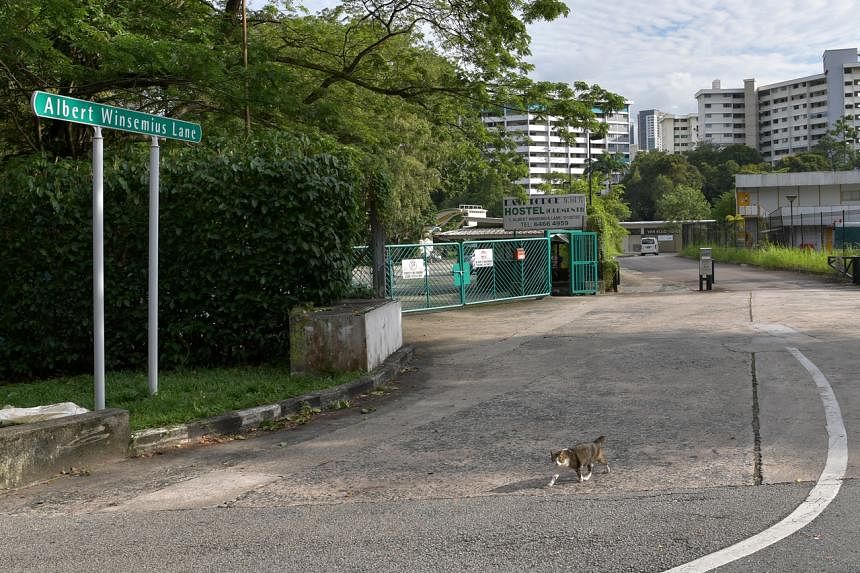
I was delighted to read that Professor Euston Quah of Nanyang Technological University has written a book on Dutch economist Albert Winsemius, who helped shape Singapore’s economic directions to its present day (Book on Albert Winsemius reveals the man behind Singapore’s economic magic, May 21).
However, I would like to highlight the sorry state of Albert Winsemius Lane, all 90m of it. It is a nondescript road leading to a National Environment Agency office.
I don’t think there are many people who can locate this lane in Singapore. I feel that it is better not to have this lane named after Dr Winsemius at all than to have it where it is presently.
It is, sad to say, an insult to the man who was Singapore’s chief economic planner for 25 years and guided our nation’s economic development as outlined in Prof Quah’s book.
I hope the relevant authorities such as the Street and Building Names Board will look into this.
N. Varaprasad (Dr)
,
============
.
Dr Goh Keng Swee: Superhero
.
May 19, 2016 | Bertha Henson linkedin
by Bertha Henson in themiddleground.sg
YOU would expect that a book by GIC about GIC is all about flattering itself. Like any corporate book. But it’s actually, really, non-fiction.
GIC had a strange birth, with its first managing director marooned in a room with just a table and an un-usable telephone. No staff. No chair. That was in 1981, when banker Yong Pung How, better known as the former Chief Justice, was “borrowed” from OCBC bank. You’d never think that the Government Investment Corporation of Singapore had such a beginning. Sans secretary. Sans chair. Sans everything that you now see in that towering edifice that is GIC Building along Robinson Road.
It sounds like fiction – because what is the point of telling a story which started with a whole bunch of scholars in a ready-made modern office, with all the right accoutrements? It also sounds like fiction because it has such a fantastic and unusual hero – and that was the late Dr Goh Keng Swee. To hear GIC tell it (or read it), Dr Goh was more than just a genius. He was a “singular man” who set up the super-structure of Singapore’s monetary policy and the reason Singapore is so rich with reserves today.
.
But do set aside any prejudices you have about a corporate book, because it is one hellavu story – non fiction – backed with interviews, newspaper clippings, telegrams, and notes typed on machines that have long been obsolete. Real information and real sources, whether from the mouths of banking pioneers or in the form of correspondence by long-forgotten names.
Which might be why GIC decided on an interactive app instead of a coffee table book, which offers the curious a chance to investigate these sources and wonder at the frenetic activity that surrounded the birth of the Singapore dollar. Yup, there are plenty of buttons to push.
Dr Goh is everywhere in this e-book, which goes by the long, unwieldy title – Safeguarding The Future – The Story Of How Singapore Has Managed Its Reserves And The Founding Of GIC. It was written by GIC’s former economics & strategy department director Freddy Orchard, and launched last Friday.
Dr Goh, who died on the 14th of May 2010, is celebrated in this book for his mastery of economics and politics, and his single-minded determination to safeguard the country’s financial security. (Yes, he also set up Singapore’s defence and even the Bird Park, but this is about GIC.)
Unconventional thinker
For example, he eschewed the conventional economic wisdom of the day and even the advice of the International Monetary Authority to have a central bank to manage, as well as issue money. Instead, he held on to the colonial institution of a currency commission which will issue notes that are 100 per cent backed by reserves. This is so that Singapore will always have to spend within its means. There would be no such thing as merely printing money to dig the economy out of a funk, which so many newly independent countries were doing.
Crystal ball gazer
He foresaw the currency separation of Malaysia and Singapore.
Now this is a story that is seldom told, unlike the political split in 1965 and the iconic television broadcast of a tearful Lee Kuan Yew. The currency split two years later was just as acrimonious.
Dr Goh was not the Finance Minister then. It was the late Mr Lim Kim San, described as an old friend of Dr Goh’s despite them being at professional loggerheads. GIC, however, credited Dr Goh for anticipating the difficulties Singapore would have with Malaysia over a common currency agreement. The proposal then was for Bank Negara to print a common currency – the ringgit – for both countries, with each retaining control over its own reserves. There would be a Singapore branch of Bank Negara.
But the sticking point came over the land in Robinson Road where the Singapore branch was to be. Kuala Lumpur wanted to retain the title to the land, maintaining that the Singapore branch was not a legal entity and therefore could not own assets. This was a red flag to Singapore, which argued that if the branch could not own property, that meant it could not be the legal owner of its reserves.
In the end, Malaysian Finance Minister Tan Siew Sin wrote to Mr Lim: “Your real fear is that we may not honour that Agreement. The only answer to this is clearly to have no agreement at all.”
.
======
.
=============
.
.
======
.
My tribute to Dr Goh Keng Swee
I wrote the following to the newspapers, and I invite comments.
.
My letter was heavily edited and it was published by Today on 17 May 2010 : “My man of the century”.
.
ST Forum did not publish it but placed it Online five days later: “He didn’t have to, but he did”.
.
Both documents are in this link:
.
================
.
My letter to Straits Times Forum and Today Voices:
Quote:
.
Dr Goh Keng Swee was from a middle-income family. He was born into wealth, not into a wretchedly poor family.
.
There was no real need for him to enter politics to struggle against the British for independence, and later the communists, the communalists, or the Malaysians, over merger and separation.
Yet, he did all that with passion.
He had a doctorate from LSE UK, and he applied and adapted what he learned from the West extremely well in Singapore and beat the British at their own game on the art of governing and development economics.
It was truly a great achievement in his short 25 years in government and politics setting up many state institutions for modern Singapore to rely on to survive and thrive.
Many Commonwealth leaders made a mess of their countries due to corruption after they had attained independence. The problems of many countries have become protracted since the end of WWII and even up till today. Not so in tiny red dot because Singapore has been fortunate to have Dr Goh.
He was the opposite compared with those who have mismanaged their countries well endowed resources whereas Singapore has none except the resolve of its people.
Singapore is a shining beacon of hope compared to the many endemic eyesores of decadence in the Commonwealth of Nations today.
Dr Goh worked for country true to his mission and compassion when he returned to red dot with his noble vision after founding the Malayan Forum while he was a student in UK.
Beyond all odds and seemingly impossible situations, he transformed Singapore into a modern-day economic miracle despite the extremely tough conditions of 1959 to 1965. A lesser man would have found the task daunting, if not impossible.
His achievements should be made into university case-study materials on development economics and government. It must become a must read and study materials for all undergraduates who aspire to become noble statesmen following in the footsteps of Dr Goh. This is the way for future generations to truly do justice to Dr Goh’s vision and sterling achievements.
Few will be able to follow in the very large footsteps of Dr Goh and emulate what he accomplished as today’s world in this age and time is driven by materialism and greed. Dr Goh was true to his compassion and genuine love in working unselfishly for the sake of the happiness of fellow human beings.
As far as I am concerned, Dr Goh is the man of the century.
Unquote.
.
=============
.
Letter from Tan Siew Sin to Lim Kim San [please see below]
.
Expert gamer
.
Dr Goh played a big part in fending off British pressure over the sterling. At about the same time as the currency split, the ex-colonial masters discovered that Singapore had more reserves than it had parked in sterling in Britain. Asked by Chancellor of the Exchequer Roy Jenkins to account for this, Dr Goh, who was back in the saddle as Finance Minister, made a distinction between monetary reserves to back the currency, and “non-monetary reserves” or other surpluses which he did not think he was “obliged to discuss with anybody where I banked them”.
.
Letter from Goh Keng Swee to Roy Jenkins [please see below]
.
Those “non-monetary reserves” provided the germ of the idea of a GIC, although it took more than 10 years to come through.
The British anger didn’t subside and plenty of pressure was put on Singapore to convert more of its reserves into sterling, even though the British had broken its assurances that it would not be devalued. There was also the looming British withdrawal which would see to the loss of thousands of jobs in Singapore. Here’s where some “wayang”, according to eye-witnesses then, was played out between Dr Goh and then Prime Minister Lee Kuan Yew, to get the British off Singapore’s back.
Sir Arthur De La Mare, High Commissioner to Singapore, suggested that London stop pressing Singapore or Mr Lee would lose control of the Cabinet and Dr Goh would take over.
.
It is an astounding document:
.
Telegram from Arthur de la Mere on the Singapore Sterling [please see below]
.
Said the author, Mr Orchard: “What is one to make of this dispatch? It seems difficult to credit the story of a breach between Lee and Dr Goh, a breach so serious as to threaten the government. All the Singaporean eyewitnesses to those times said this was “wayang” (play-acting), just the two top Singaporean leaders divvying up the good cop/bad cop routine between them.”
There was no Cabinet split, and Dr Goh went on as Finance Minister, Defence Minister, and Deputy Prime Minister in charge of Monetary Authority of Singapore. “What sort of breach could have occurred in 1967, if the succeeding years witnessed the continued close collaboration of these two giants among Singapore’s founding fathers?”
So genius, economist, actor and also buccaneer? The GIC book devoted one chapter to some cloak-and-dagger activities that Dr Goh engaged in, buying gold from South Africa when there was an embargo imposed. Big banking names like Wee Cho Yaw and Lien Ying Chow helped civil servants like Ngiam Tong Dow in the transactions, with one half of torn US dollar note identifying themselves as prospective buyers.
.
Ngiam Tong Dow with the torn US dollar note [please see below]
.
This is no dry exposition of monetary policy, even though the author says in the prologue that the story of reserves management “seemingly lacks the drama and heroic deeds that stir the blood”. It is filled with flesh-and-blood characters and illuminates the derring-do of a pioneer generation of civil servants and bankers.
If there is one drawback of the book, it is so much of a paean to Dr Goh that we’re left thinking that he made no mistakes. His decision later to set up the Monetary Authority of Singapore – a central bank by any other name, was justified as part of a longer term strategy he had – not a contradiction.
.
Clearly his staffers were enamoured of the man known for his keen intellect, frugality, forthrightness, and hands-on approach. You’re left wondering if the current generation has the same unconventional mindset and firmness of conviction.
Let’s hope that there are more Dr Gohs among us.
Featured Image by Natassya Diana.
If you like this article, Like The Middle Ground‘s Facebook Page as well!
.
==
.
Letter from Tan Siew Sin to Lim Kim San:
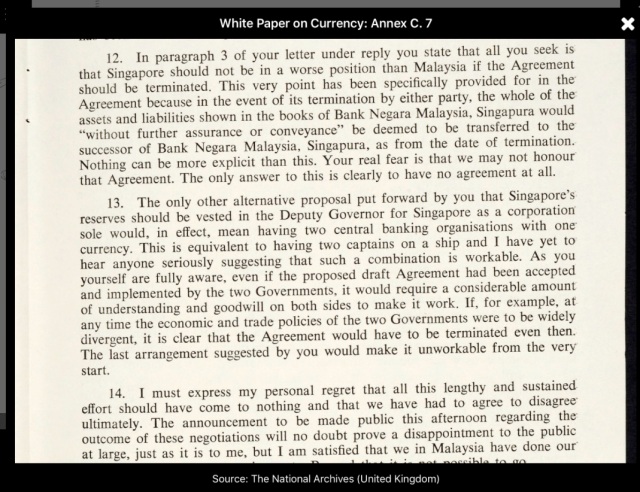
.
===
.
Letter from Goh Keng Swee to Roy Jenkins
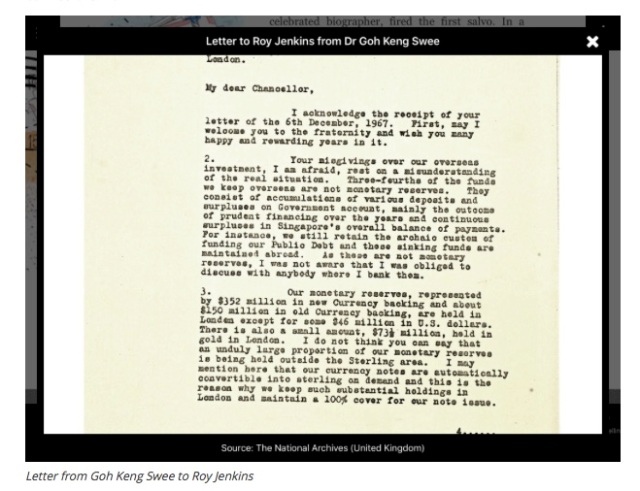
.
====
.
Telegram from Arthur de la Mere on the Singapore Sterling
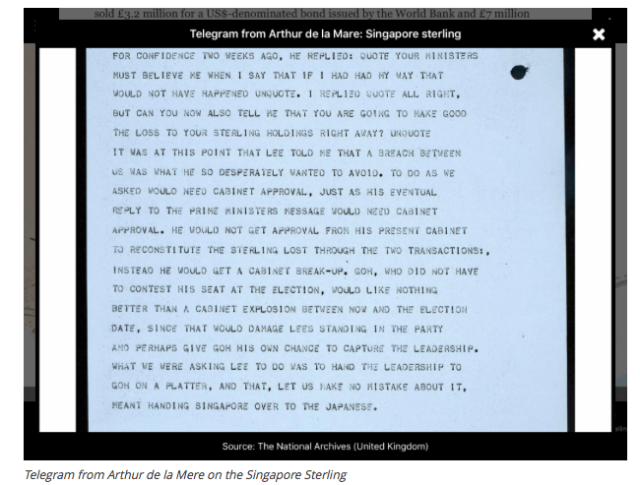
.
===
.
Ngiam Tong Dow with the torn US dollar note
